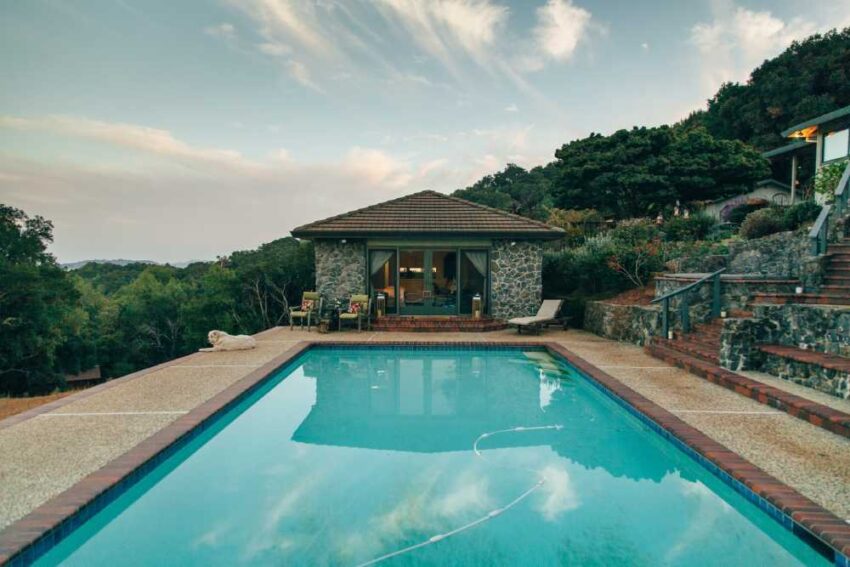Replastering is a pool renovation that involves putting a new plaster on your pool’s walls and bottom. This is done to spruce up your swimming hole and repair damage from wear and tear.
The first step in replastering is applying a bond coat to the surface of your pool. This is typically made from muriatic acid and an acrylic-modified mixture of cement and sand.
How It’s Done
Pool plastering is the application of a thin layer of cement-based material to the interior surface of your pool. The result is a bright, smooth, attractive, durable finish.
Several options for your pool’s plaster, including white and colored. A popular choice is an aggregate plaster comprising small stones (usually quartz, granite, or river stones) and regular white pool plaster. Aggregate plaster gives your pool a textured look and is more resilient than standard white plaster.
Another option is a fiberglass coating. This is a highly durable finish that’s resistant to staining and etching. It comes in various colors and can be custom-tinted to match your desired look.
Ultimately, how long your plaster lasts depends on the materials used and how well you care for it. By keeping your water chemistry balanced, avoiding corrosive environments, washing acid as much as possible, and brushing regularly, you can prolong the life of your plaster and enjoy your pool for years to come.
We’ll wash your pool walls with muriatic acid once the hallows are pounded out and cracks have been handled. This process aids in the removal of tenacious stains that brushing and sequestering agents cannot tackle and helps roughen up the surface, allowing the bonding agent to adhere to it better.
Preparation
When you build a new pool, the rough concrete shell is first covered with a “brown coat” (an intermediate layer of cheap plaster). It smooths the rough surface and brings it to its final form. After the brown coat is cured, the finish plaster can be applied. This same principle applies when your pool is replastered.
Before the plaster is applied, removing any hydrostatic pressure that may be building up underneath your pool is essential. It will prevent the entire pool from “popping up” once the plaster is in place. Once the hydrostatic pressure is removed, we can get started.
In addition to removing debris from the waterline tiles, we must undercut all plumbing, jets, returns, and main drains. It will allow us to work around them and apply the plaster as close to their original position as possible.
Once the pool is prepped, a specialized bonding material ensures that the old and new plaster surfaces adhere together. This material is cement acrylic modified and is applied with a trowel to the existing surface of your pool.
This process can take several days, as the pool will require daily brushing and backwashing to prevent calcium hydroxide from affecting the new plaster surface. This dust will dull the plaster’s appearance and make it harder for your water chemistry to be correctly balanced. For this reason, it is essential to maintain a high level of Alkalinity (also known as Carbonate Alkalinity) and a lower LSI (Liquid Specific Inertia).
Applying the Bonding Agent
Pool plaster separates your pool water from the concrete underneath and protects it from deterioration. It enhances the design of your pool and adds to its aesthetic value while providing a smooth surface that is comfortable for swimmers to swim on. It also extends the life of your swimming pool.
During the mixing process, technicians carefully monitor the consistency of the plaster. It must be just the right texture—not too dry or wet. This is important because if it’s too dry, your plaster won’t adhere to the pool’s surface correctly. Too wet, and it will crack or shrink as it dries. It’s a delicate balance that only an experienced professional can achieve.
Modern plaster is a mix that contains polymers (fancy name for plastics). These additives improve the bonding to your existing pool surface, curing requirements, strength, and chemical resistance. They are added during on-site mixing in the same way paint is mixed today.
Once the plaster is mixed, it’s applied to your pool’s surface using a steel trowel. We always aim for a smooth transition from old to new pool plaster. Rough surfaces collect dirt and algae over time, turning your beautiful pool into an eyesore. A thorough acid wash may be in order if your pool is patchy before replastering.
Applying the Plaster
Pool plaster is a layer of white cement covering your pool’s interior surfaces. It protects the internal surface from damage, extends the life of your pool, and adds an attractive design element to your pool’s interior.
However, if you do not care for your pool correctly or it is damaged by normal wear and tear, it can begin to degrade. When this happens, you will notice flakes of the gunite or shotcrete underneath showing through the plaster. This is a sign that it is time to replaster your pool.
To start the process, the pool must be drained and acid-washed. Hallow areas are pounded out and cracks repaired, and the existing plaster surfaces must be roughened by washing with muriatic acid. This process removes the slick sheen developed on the old plaster and helps the new plaster better adhere to the surface.
The plaster mix is now ready to be troweled in place. The blend must be just right; too dry, and it won’t stick; too wet, it will run and crack. Pool experts always know how to get the perfect mix for a quality plaster job.
Once the plaster is applied, a specialized bonding agent must be added to ensure that the plaster and the old plaster adhere together. This material is called Bond-Kote, consisting of a one-part resin and acrylic-modified cement and sand mixture. This is sprayed or rolled over your pool’s entire surface, allowing the new plaster to bond with the existing plaster.

